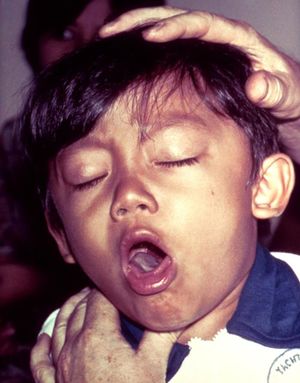We need you! Join our contributor community and become a WikEM editor through our open and transparent promotion process.
Pertussis
From WikEM
(Redirected from Bordetella pertussis)
Contents
Background
- “Whooping cough”. The “whoop” is caused on inspiration between coughs.[1]
- Most common in kids < 1yo, because they haven’t completed the whole vaccine series, AND adults, who have waning immunity.
- One of the only vaccine preventable diseases that has increased in prevalence recently
- Up to 20% of adults with cough >2 weeks have serologic evidence of pertussis[2]
- Bordetella pertussis, a gram-negative coccobacillus
Pathophysiology
- Transmitted by aerosolized droplets, extremely contagious
- Infects ciliated respiratory cells (rarely goes hematogenous), creates toxins damaging respiratory epithelium.
Clinical Features[3]
- Incubation period several days-3 weeks
- 3 stages:
- Catarrhal phase: lasts 1-2 wks. Clinically indistinguishable from other URIs; dry cough starts near the end. Greatest infectivity phase.
- Paroxysmal phase: lasts 2-4 weeks => fever improves, cough worsens. Staccato cough + whoop (present in 1/3 kids), post-tussive emesis (often in adolescents, adults). Infants can present as apnea. Patients often appear well between coughing episodes.
- Petechiae, epistaxis, pneumothorax, and/or subconjunctival hemorrhage may occur due to high intrathoracic pressures during coughing.
- Convalescent phase: lasts weeks-months; residual cough
Sequelae
- Pneumonia superinfections
- Rib fracture
- Pneumothorax
- Aspiration of gastric contents
- CNS complications
- Mucous plugs, obstructed airway
- Secondary bacterial infection
- Increased intrathoracic pressures
- Rectal prolapse
- Ruptured diaphragm
- Hernia
Differential Diagnosis
Pediatric fever
- Upper respiratory infection (URI)
- UTI
- Sepsis
- Meningitis
- Febrile seizure
- Pneumonia
- Acute otitis media
- Whooping cough
- Unclear source
- Kawasaki disease
- Neonatal HSV
Evaluation
- WBC elevated in infants (20-100) with large amount of lymphs (85%), adults and infants < 6 mo may be WNL
- CXR with peribronchial thickening, atelectasis, and/or consolidation
- Nasopharyngeal swab can identify it in 3-7 days; often neg in adults.
- Cough for >2 weeks, post tussive emesis, feeling well otherwise, treat them empirically. Especially if infant or pregnant people at home.
Management[4]
Acute Disease
- Supportive
- Suction in infants, hydration. Neonates with apnea should be admitted to the ICU.
Antibiotics
- Antibiotics do not help with severity or duration but may decrease infectivity.
- A reasonable guideline is to treat persons aged >1 year within 3 weeks of cough onset and infants aged <1 year and pregnant women (especially near term) within 6 weeks of cough onset. [5]
- TMP--SMZ should not be administered to pregnant women, nursing mothers, or infants aged <2 months.[6]
- The following regemins are for active disease or postexposure prophylaxis. If a patient is has confirmed disease and is likely to be in contact with infants or pregnant women then the patient should be treated as up to 6-8 weeks after the onset of their illness.
< 1 month old
Same antibiotics for active disease and postexposure prophylaxis
- Azithromycin 10mg/kg (max 500mg/day) daily x 5 days
>1 month old
- Azithromycin 10mg/kg (max 500mg/day) daily x 5 days
- if > 6 months old then day 2-5 of treatment should be reduced to 5mg/kg (250mg/day max)
- TMP/SMX 4mg/kg PO BID daily for 14 days (if > 2 months old)
Adults
andy of the following antibiotics are acceptable although azithromycin is most commonly prescribed
- Azithromycin 500mg PO once daily for day #1 then 250mg PO once daily for days #2-5
- Clarithromycin 500mg BID x7 days
- Erythromycin 500mg QID x7 days
Isolation
- Droplet
Post-Exposure Prophylaxis[7]
- Prophylaxis for all household exposures of known Pertussis
- High risk people exposed to pertussis: infants, women in 3rd trimester of pregnancy, immunocompromised, severe asthma, people with close contact to infants <1year, people who work in neonatal ICUs / maternity wards.
- Patients are considered infectious for 3 wks after start of paroxysmal phase, or after 5 days of antibiotics
Prevention
- Vaccinate women during each pregnancy preferably between 27-36 wks, regardless of previous Tdap admin
- Immunity wanes 8 y after immunization. Often elderly will get the disease and transmit it to young unimmunized infants.
Tetanus Vaccine Selection Guide
| Age | If No Pertussis Contraindications | If Pertussis Contraindicated | Comments |
| 2mo - 7yrs | DTaP | DT | DT available from pharmacy |
| 7yrs - 10yrs | Td | Td | |
| 10yrs | Tdap(Adacel)^ | Td | ^Off label use, but appears safe and immunogenic |
| 11yrs - 16yrs | Tdap(Adacel) | Td | |
| 16yrs - 65 | Tdap(Adacel)^^ | Td | ^^Use Td if patient is known to have received prior Tdap |
| 65yrs + | Td |
Td |
Consider TIG for tetanus prone wound plus Td(tetanus immune globulin) |
Caveats
- Adolescents who have already gotten a booster dose of Td are encouraged to get a dose of Tdap as well. Waiting 5 years after their last Td is encouraged but not required. A period of at least 2 years between Td and Tdap is recommended in these cases.
- Pregnancy is not a contraindication to Tdap.
- Stable neurologic disorders and family history of vaccine reactions are not contraindications to receiving these vaccines.
- No vaccine has ever been shown to play any role in the development of autism or autism spectrum disorders.
See Also
References
- ↑ Frumkin K. Pertussis and persistent cough: practical, clinical and epidemiologic issues. J Emerg Med. 2013 Apr;44(4):889-95.
- ↑ Trends in hospitalizations and resource utilization for pediatric pertussis. Hosp Pediatr. 2014 Sep;4(5):269-75
- ↑ “Pertussis: Clinical Features”. Centers for Disease Control and Prevention. http://www.cdc.gov/pertussis/clinical/features.html. Sept 4, 2014
- ↑ *“Pertussis Treatment Options”. British Medical Journal Best Practice. http://bestpractice.bmj.com/best-practice/monograph/682/treatment.html. Sept 3, 2014.
- ↑ CDC - Pertussis http://www.cdc.gov/pertussis/clinical/treatment.html
- ↑ CDC MMWR Pertusis http://www.cdc.gov/mmwr/preview/mmwrhtml/rr5414a1.htm
- ↑ “ Pertussis Postexposure Antimicrobial Prophylaxis”. Centers for Disease Control and Prevention. http://www.cdc.gov/pertussis/outbreaks/pep.html. Aug 28, 2013

